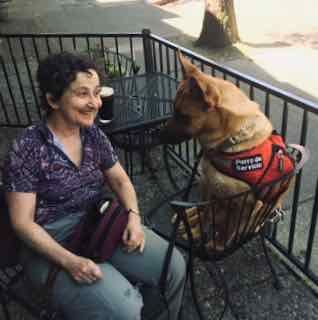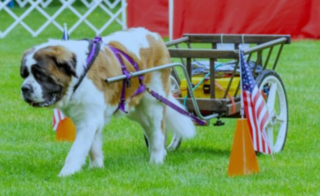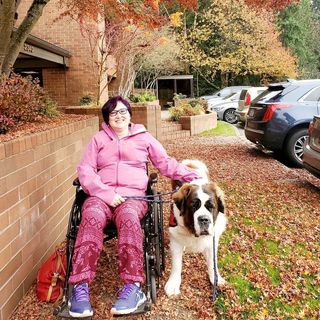A letter to the editor of our local Food Coop grocery store complained that he is “allergic to animals” and does not want any of them—including service animals—in the grocery store,. He complains that people who don’t look like they have any problems are bringing pets into the store, and he feels this is unclean and unsafe.
Interestingly, one can argue that this person (who used a masculine pronoun) has an invisible disability. Thus, we have no way to know how to help him unless he wears a cape, scarf or tie that says Allergic to Animals. It is a horrible thing, I would imagine, to be allergic to animals generally. You couldn’t go to the zoo, the beach, the Aquarium or even a park because there are animals all over the place, from birds to frogs, snails, slugs, ants, and beetles. And, oh yes, dogs.
His claim that the dogs are dirty is interesting because the vast majority of infectious diseases are spread from person to person, not animal to person (i.e., they are not zoonotic). There are probably more pathogens in a kindergarten class than in a doggy day care—certainly, more that are transmissible to people, because after all, they are living in people! It is mostly people who spread colds, staph infections, TB, HIV, and so on to other people.. In terms of infectious diseases, human beings are much more dangerous to one another than is any animal, with the possible exception of diseases spread via vectors like mosquitos and ticks, or some of those terrible hemolytic viruses that can contaminate bat poop.
Humans catch diseases from animals like the Aedes aegypti mosquito (dengue, malaria, chikungunya, Zika fever, and yellow fever viruses) or ticks (Lyme disease, Anaplasmosis, Babesiosis, Ehrlichiosis, Rocky Mountain Spotted Fever). It is true that people can catch rabies from bats. I would not personally condone adopting wild bats in areas where rabies is endemic. However, as bizarre as claims for service animals sometimes go, I have not yet heard of anybody with a service bat. If such people-bat connections exist, it would give me pause.
The World Health Organization notes that infectious diseases are the most common cause of disability in the world, at 37%. Infectious and parasitic diseases, especially lower respiratory tract infections, diarrhea, AIDS, tuberculosis, and malaria are the major causes of disability. These are not spread by cats or dogs, but mostly human to human contact or contact through an insect.
I have a service dog. If I saw a person wearing a tie, pin or t-shirt that said “allergic to dogs” or “dismayed by dogs” or “allergic to animals” I would happily maneuver my service animal to avoid the problem. I’d want to be helpful, respectful and compassionate. If the table were turned, I would hope that folks who see my dog in her identifying uniform would similarly want to help me, if only by tolerating her. I look ok on the outside, so there is no way that an observer could readily validate my need for my dog. I suffer from an invisible disability, one that is medical and not emotional, just like the letter-writer who is allergic to animals. Common social standards do not require me to write my medical diagnosis on a visible tag. In fact, most of us value confidentiality. Walking around with a dog who wears a bright red vest that says Service Dog already makes me vulnerable because I have disclosed to the public that something is wrong. That should be enough transparency.

My point is that people with allergies or fears of animals are entitled to respectful adjustments on the part of the rest of us. But rather than complain about adaptations being made by those of us with service animals, he or she or they would do well to identify him- or her- or themselves just as I do, and expect tolerance if not empathy. Just as I do.
The vast majority of maladies among Homo sapiens are internal and not visible to strangers. From psychiatric disorders like autism to hormone disorders like diabetes, a person can suffer with many different problems without any visible indications. I used to specialize in helping people with cancer. One of my early patients was a woman who was abruptly diagnosed with stage 4 breast cancer when she fractured her hip in a folk dance class. She was 38. She had been treated for stage 1 breast cancer a decade before, but despite careful medical monitoring there was no evidence that she was ill until one day she collapsed at dance class, unable to walk. I wrote her a prescription for a service dog, and helped her find a very mellow Cavalier King Charles Spaniel. The dog’s job was to encourage her to learn to walk again, an encouraging physical therapy coach, once her hips were repaired, after which he then helped with her adjustment disorder. She lived another 15 years, outliving Service Dog #1, and had two more.

Then there is my friend, A, who uses service dogs. A is only 42, but she has been quite ill for 20 years with severe lupus, an autoimmune disorder that has cursed her joints, lungs, blood vessels and brain. Here is a link to a special award her dog Polly won from the American Kennel Club because Polly is not only a service dog but an athlete.
Now, Polly takes up quite a bit of space; she is a Saint Bernard. She has long hair, big feet, and occasionally she drools. But she has saved A’s life. When A has had pneumonia or pulmonary embolisms, Polly has detected them even before these dangerous illnesses became clinically evident. She can also pull A’s wheelchair if A needs help, and on vacations, Polly helps her through soft sand and onto the beach.
To paraphrase "Old Town Road," If you see a brave woman with a big wheelchair and a large dog, you just gotta let ’em fly.





